Capacitance is the ability of a capacitor to store energy. We measure this parameter using a capacitance meter or a multimeter.
But the interesting question is…
How to measure capacitance without multimeter? Is it even possible to do so or not?
Well, this is what we will discover in this article.
At the end of this article you should be able to know:
- How to measure capacitors without using any digital multimeter.
- Different alternatives for measuring capacitance
- Capacitance measuring general theory
- How to note down the capacitance value from the capacitor body
- How to use ESR value to measure capacitance
- How to use the time constant to measure capacitance, and so much more
Sounds interesting? Then I am sure you will enjoy the rest of this article.
Let’s get started.
How to measure capacitance without multimeter?
A capacitor is a two terminal circuit component that we use for noise filtering, signal smoothing, and energy storing.
I believe you will find this component in almost every electronic circuit. The reason is, we need signal smoothing or voltage referencing in almost every circuit design.
Following is the circuit symbol and a few real time capacitors:
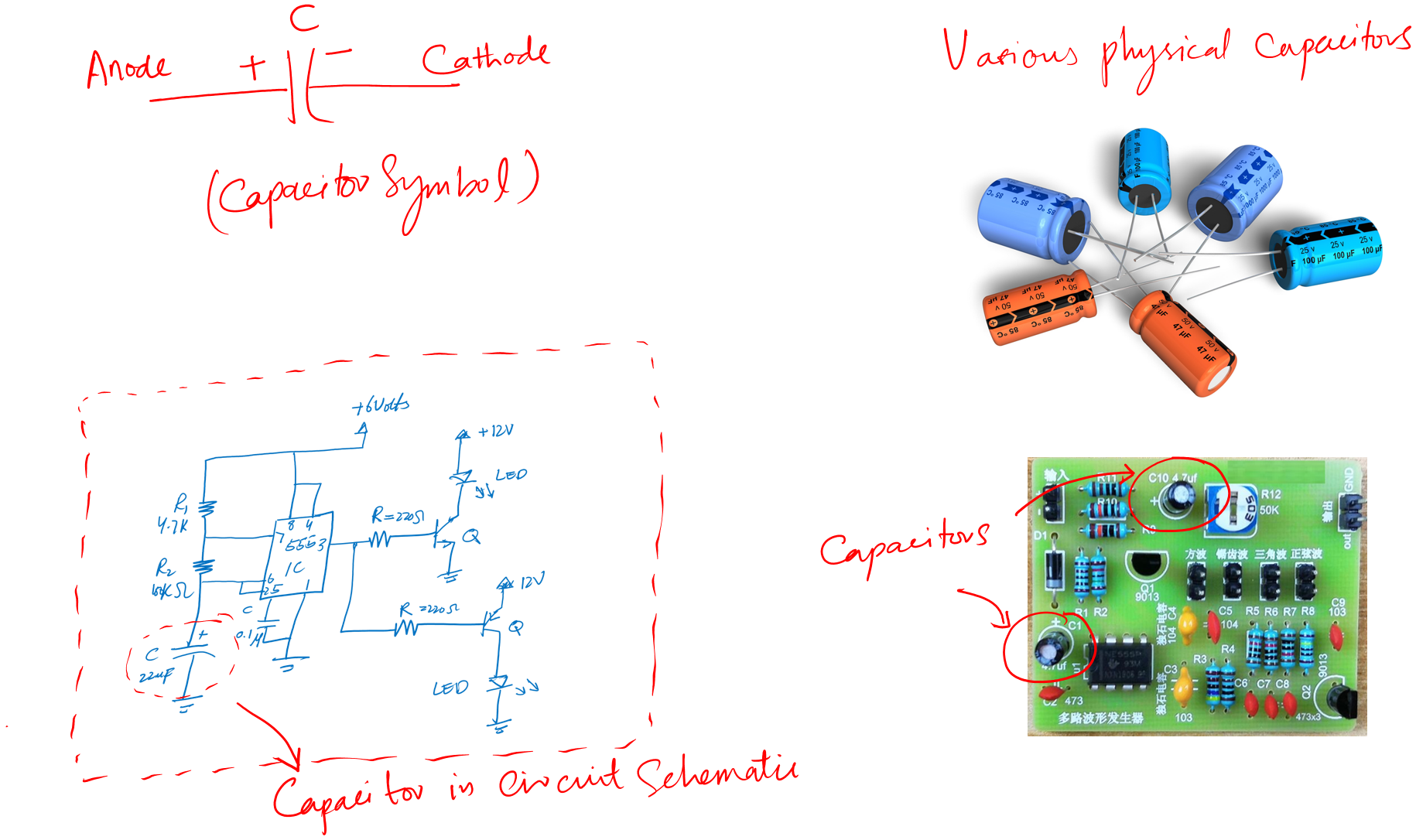
You can see, it has two terminals. For electrolytic capacitors, one terminal is the anode (+) and the other terminal is the cathode (-).
Capacitor comes in two main types:
- Electrolytic capacitor
- Ceramic capacitor
Electrolytic capacitors are polarity depended. You need to connect the positive anode to the positive terminal of a voltage source and the negative cathode to the negative terminal of the voltage source.
While ceramic capacitors don’t depend on polarity. You can connect them in any direction. They will work the same.
Following is the diagram of ideal and real time capacitors.
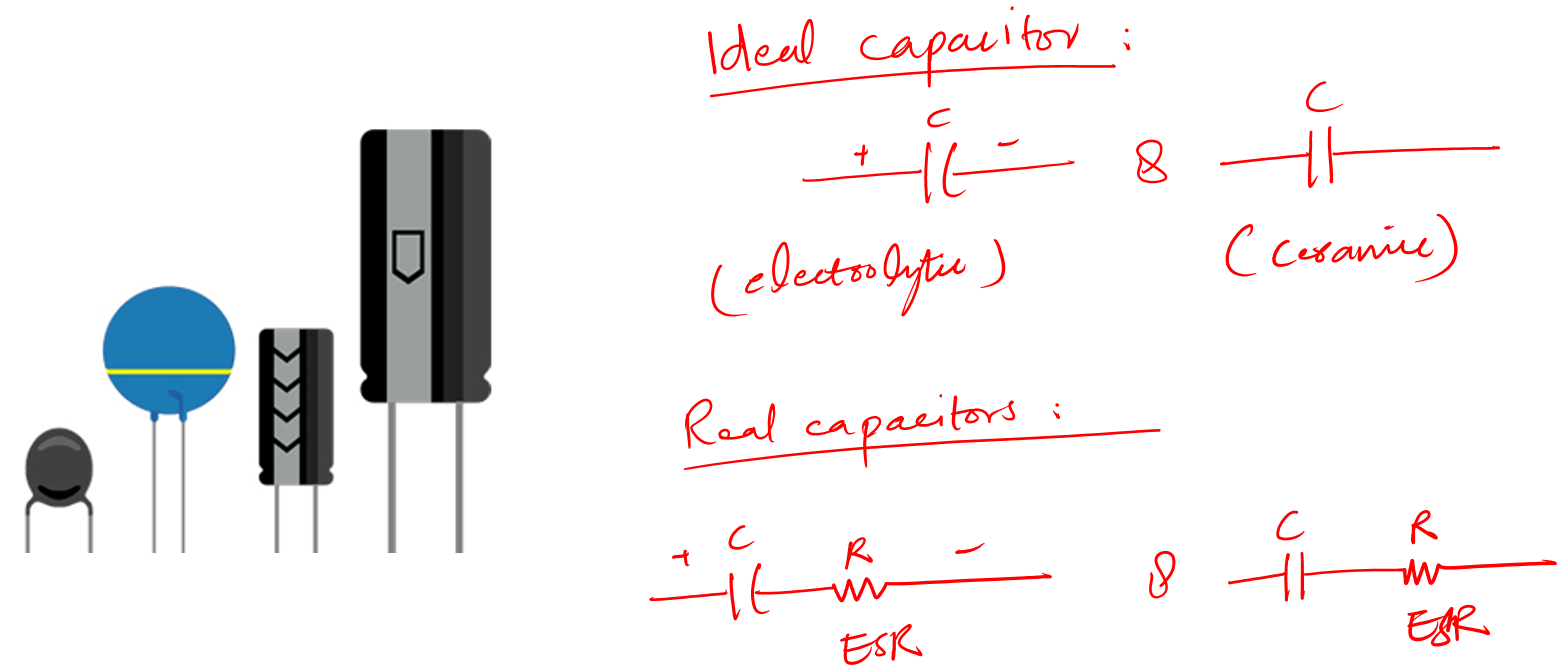
Real time capacitors have additional equivalent series resistance (ESR).
No matter what type of capacitor we work with. It is important to know its capacitance value. How do we know this value?
The topic of this article is how to measure capacitance without multimeter or capacitance meter.
Let’s find out how.
1. Reading the capacitance directly from the capacitor
This method is the easiest and most effective way to measure capacitance without multimeter. In fact, you don’t have any meter or any tool for this method.
Follow the below easy steps for an electrolytic capacitor:
- Take your electrolytic capacitor
- Discharge it fully before touching it
- On the body, you will find the written capacitance value for rated maximum voltage and tolerance.
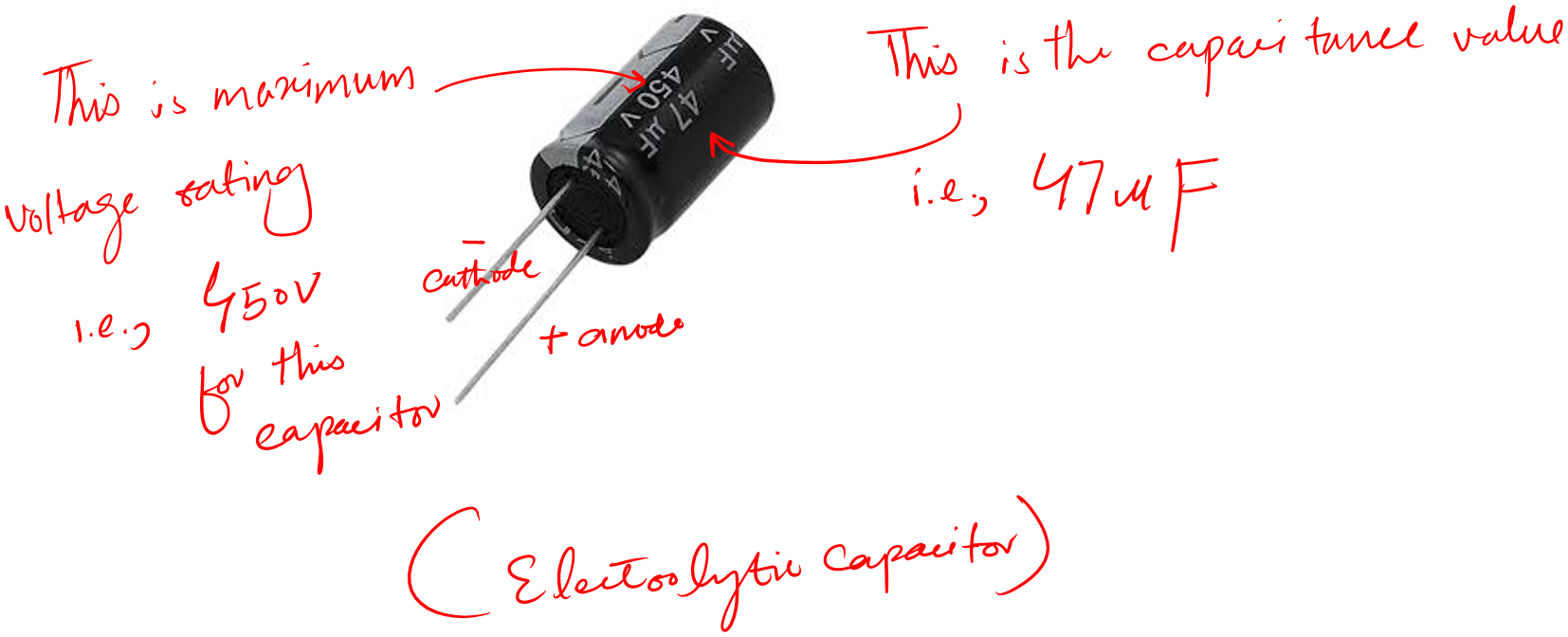
- It is that simple.
Follow the below easy steps for a ceramic capacitor:
- Take your ceramic capacitor and note down its written code
- The first two digits (starting from the left) of the code are the capacitance value
- The rest are 10 multipliers
- As ceramic capacitors are small caps they are measured in pF, nF, uF.
- For example:
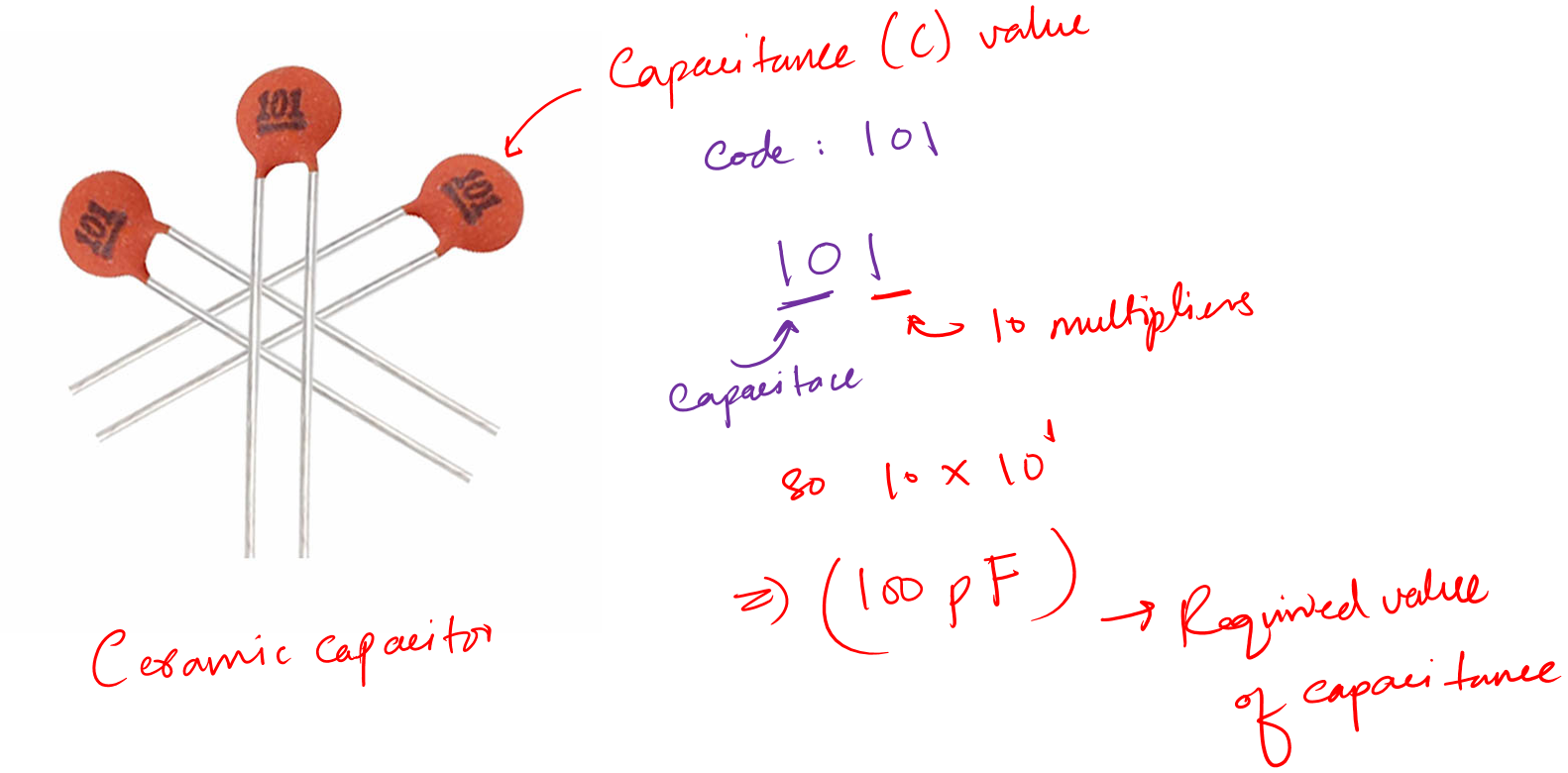
Following is the ceramic capacitor code and its equivalent capacitance chart for your reference.

Alright!
The above method is a widely used method for measuring capacitance value without using any multimeter.
You can tell that it is very straight forward.
But this method inherits a problem. You can read the capacitance value using this method. But you can only be sure that the capacitor is good only if that capacitor is brand new.
If you are working with old capacitors. Then I believe this method can lead to false readings.
And that is why it is not a good idea to check for capacitance without having a decent multimeter in practical situations.
Yes, the method is helpful, but it is limited. You can not use this method for testing a capacitor if it is bad or good, or even if it is actually providing that written value or not.
Let’s expand our knowledge circuit and see what other options do we have instead of using a multimeter.
2. Using a component tester
I believe you will like this method more than the above ones. Why? Because it is very simple.
A component tester is a device like a multimeter or capacitance meter. But it is geared toward testing and measurement both.
While a multimeter just does the measurement and leaves the capacitor testing to the person’s knowledge and experience.
A component tester solves this problem. And tell you directly if the component is bad or good. Leaving the guesswork.
Following is the m328 (Amazon link) component tester.

To use this mentioned tester for capacitor testing, follow the following steps.
- Take your capacitor and the m328 tester
- Turn on the tester and put the capacitor in the socket
- Remember to discharge the capacitor first, else it may damage the component tester
- This is so important and crucial, if you accidentally forget this step (discharging your capacitor), you may end up destroying your meter. For extra knowledge, always discharge a capacitor before measuring any parameter of it.
- Discharging of a capacitor can be done by shorting its legs by any available means. But don’t just short the legs together with low resistance wire, a good practice is to use a high resistance material.
- Press test button
- See the capacitance and ESR value if the capacitor is fine
- Else the tester will show a message on the screen saying that the capacitor is bad
It is that simple.
3. Using an Oscilloscope
Yes, you can measure the capacitance value using an oscilloscope as well.
You know, if you are reading this blog. This means you want to have knowledge about electronics.
Right?
Well…
The only practical way to measure capacitance without multimeter is by noting the written value on the capacitor body. Which we covered in the above section.
The rest of the methods is my try to share the knowledge that without a multimeter what are the other possible solutions?
And using an oscilloscope is of those many options for measuring the capacitance of a capacitor.
The question is how?
Well, the time constant is one of the amazing parameters of a capacitor that we can use for this method.
The time taken by a capacitor to charge up to 63.2% of the given voltage source is called the capacitor time constant.
Let’s see the mathematics behind it so that you can clearly understand what I am saying here.
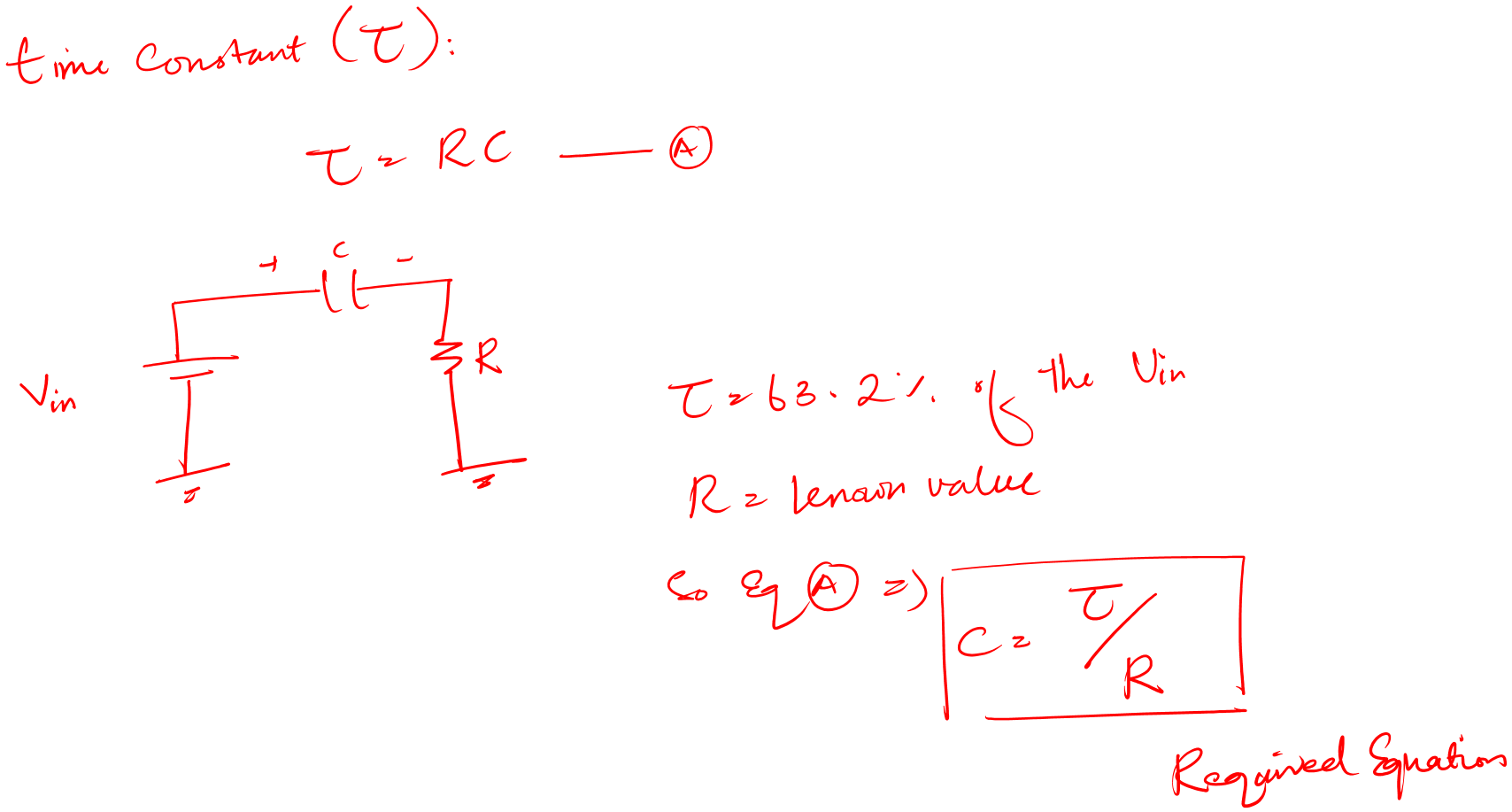
For this method, you would need an oscilloscope to measure the time constant.
- First discharge your capacitor
- Then connect the capacitor in series with a 10K resistor
- Connect this series resistor with a voltage source
- Connect the oscilloscope to the capacitor and note down the charge time when the capacitor charges up to 63.2% of the connected power supply
- After that using the above equation and measure the capacitance
- This is how you measure capacitance using an oscilloscope
- After this, you can also do the following
- Compare this capacitance value to the one given on the capacitor body
- If they match you have a good capacitor
- Else your capacitor is the bad one
Capacitor discharging
A capacitor is a charge storing device. Meaning that it can have stored charges even if it is not connected to the circuit.
So, it is very important to play safe with this component. Else it can give you an electric shock and can fully damage your measuring device.
After understanding the above threat of a highly charged capacitor we must know how to discharge a capacitor before working with it.
How to discharge a capacitor?
Well, there are a couple of ways in which you can discharge a capacitor.
For example:
- Using a screwdriver
- Using a discharge resistor
- Using a high resistance pliers
Using a screwdriver
Follow the below easy steps for discharging a capacitor using a high resistance screwdriver:
- Take an insulated screwdriver (with a longer handle) and hold it in one hand.
- Take the capacitor in the other hand and touch the metal part of the screwdriver to both the terminals of the capacitor.
- You will see sparks and hear some crackling sound as an indication of electric discharge.
- Repeat a couple of times to make sure that the capacitor is completely discharged.
Using a high resistance pliers
Follow the below easy steps for discharging a capacitor using a plier (a simple tool):
- Repeat the same step as we did for the screwdriver. But this time use a plier instead of a screwdriver.
- Pliers are more effective than screwdrivers, in my opinion.
Using a discharge resistor
Follow the below easy steps for discharging a capacitor using a resistor:
- Take a large value resistor (usually, a few kilo Ohms) with a high power rating (like 5W) and connect it across the terminals of the capacitor.
- Instead of directly connecting, you can make use of wires with crocodile clips on both ends.
- The capacitor will slowly discharge, and you can monitor the voltage across the terminals of the capacitor with a multimeter.
Conclusion
Capacitors are two terminal passive components that we use for various roles in our circuits. Such as filtering, noise cancellation, and energy storage.
The issue with capacitors is that with time they degrade and need to be replaced.
Also, for the new project, we need to first verify if the capacitor is good or bad before placing or soldering it in the circuit boards.
So, to make sure we have good capacitors. We need to test and verify them.
For this, we need to measure its capacitance value.
Usually, we use a multimeter and capacitance meter for measuring the capacitance value.
But is it possible to measure capacitance without multimeter?
Yes, it is.
We can measure the capacitance of a capacitor from the body of a capacitor.
- On an electrolytic capacitor, the capacitance value is written on the body
- For ceramic capacitors, we need to read the code on its body.
Other than these we can try a component tester and oscilloscope as well.
Alright!
So that is it. That is all I have for you about how to measure capacitance without using a digital multimeter. I hope you enjoyed my limited knowledge effort.
Thank you and have grateful life.
Other useful posts:
- Capacitor anode cathode identification (2 Easy ways)
- #10 Capacitor functions in circuits (Some best uses)
- What is a capacitor in electronics (Easy beginner guide)
- Electronic capacitor testing (5 Easy testing methods)
- Test Capacitor Without Desoldering [In-circuit Testing]
- 6 Best methods of capacitor measurements (Easy Guide)
